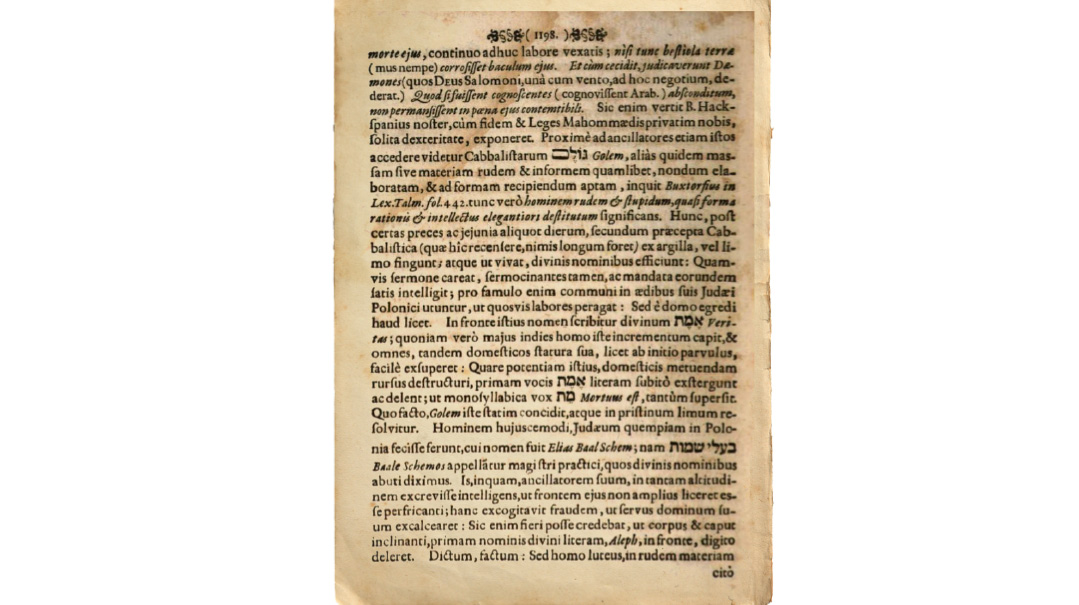The Original Golem
| February 27, 2024The fact that father and son dealt with the same curious theme hints at some family history behind the discussion

Title: The Original Golem
Location: Chelm, Poland
Document: Letter from Christoph Arnold
Time: 1674
One of the most unusual questions raised in classic responsa comes from the Chacham Zvi, Rav Tzvi Hirsch Ashkenazi. The Chacham Tzvi wondered if a golem may be included in a minyan. Although he remained undecided, his son Rav Yaakov Emden ruled unequivocally that a golem can’t be counted toward a minyan. The fact that father and son dealt with the same curious theme hints at some family history behind the discussion. Both of them make reference to an early medieval golem said to have been created by their ancestor, Rav Eliyahu Baal Shem of Chelm (the Chacham Tzvi’s grandfather was married to the granddaughter of Rav Eliyahu).
Rav Eliyahu was born in the early 16th century and joined the yeshivah of the Maharshal in Lublin. He was soon hired as rabbi of Chelm, a position he held for the rest of his life. He continued to maintain a close relationship with the Maharshal, who held him in high esteem. In 1564, Rav Eliyahu gathered with other prominent rabbis, including his teacher, to cosign a halachic ruling allowing an agunah to remarry.
The golem creation story comes courtesy of Rav Yaakov Emden, who writes in his autobiography Megillas Sefer:
Rabbi Eliyahu Baal Shem the Elder, of blessed memory, who was a rabbinical judge in the holy community of Chelm in those days, created a man, and [my father, Chacham Zvi] relates that this creature was mute and served him as a slave.
Seeing that his creation was becoming very strong and large, by means of the name written on a paper stuck to its forehead, Rabbi Eliyahu Baal Shem feared that it might do great harm, and that it might even destroy the world. He quickly overpowered it and removed the parchment from its forehead. It fell to dust as it was, but it harmed its master; it scratched him on the face when he detached the name from it.
An additional source is found in the archives of Oxford University. A manuscript authored by an unnamed “Polish Jewish Kabbalist,” sometime during the period 1730–1750, states:
I have clearly heard from several respectable individuals that there was a man not long ago in the holy community of Chelm named Rabbi Eliyahu Baal Shem who created a creature from clay, forming a golem. He engaged in this lengthy task for an extended period. He placed a truth-inscribed charm around its neck, and eventually, for some reason, he removed the charm from its neck, causing the golem to return to dust.
An even more detailed description of the affair was provided by Christoph Arnold, who wrote of it in a 1674 letter to a friend named Wegenzil. The letter, written in Latin, is cited by Professor Gershom Scholem in his essay “The Idea of a Golem”:
Polish Jews say that there was a Jew in Poland named Rabbi Eliyahu Baal Shem who made a golem from lime for the purpose of being a servant and doing housework. It was animated by having the the word emes (truth) written on its forehead.
But it kept on growing and getting stronger. To stop this, the alef needed to be erased from the word emes, leaving the word meis (dead). And when the rabbi noticed that the servant had grown so large that he could no longer reach its forehead and erase the letter, he came up with the trick of commanding the golem to take off its boots, assuming that when the golem bent over, he could erase the letter from its forehead. And so it was, but when the golem returned and turned into clay, all its weight fell on the rabbi and crushed him.
Stories of Chelm have become a significant popular phenomenon in East European Jewish folklore. Perhaps the story of Rav Eliyahu (which changed many times over the years) is a reason for the city’s folkloric status, which is based solely on conjecture and only took off in the early 20th century.
The Gra’s Golem
While the story of the Golem of Prague has largely been dismissed as legend, there is yet another story of a “Rav Eliyahu” engaging in the creation of a golem. Rav Chaim Volozhiner recounted in the preface to Sifra d’Tzeniusa that he showed the Vilna Gaon ten interpretations of a passage from the mystical Sefer Yetzirah, seeking help in identifying the correct version. The Gaon immediately pinpointed the right interpretation. Rav Chaim suggested that with such discernment, the Gaon could potentially have created a living being. The Gaon revealed that he had attempted to create a golem when he was younger than 13 years old, but a Divine message instructed him to stop.
From One Baal Shem to Another
In the sefer Nezer Hakodesh — Minhagei Beis Ropshitz, a story is told about the Baal Shem Tov, in which he mentions Rav Eliyahu Baal Shem, who had saved the Jews of a certain town from eviction by successfully promising the childless non-Jewish mayor a son within a year. The Baal Shem Tov mentioned that this tzaddik, who lived in the late 1600s, was the same one who established the custom of reciting L’Dovid during Elul. However, it is unclear to whom exactly he was referring to, as there were by then several figures referred to as “Baal Shem,” although Rav Eliyahu of Chelm is said to be the first known by that title.
This article was enriched by the research of Shimon Steinmetz, Eli Eshed, and Hillel Kieval, whose work was instrumental in its preparation.
(Originally featured in Mishpacha, Issue 1001)
Oops! We could not locate your form.






